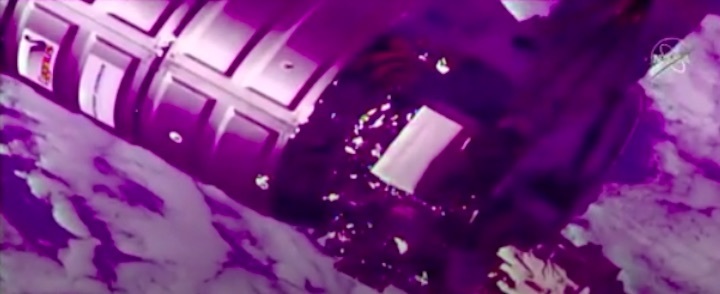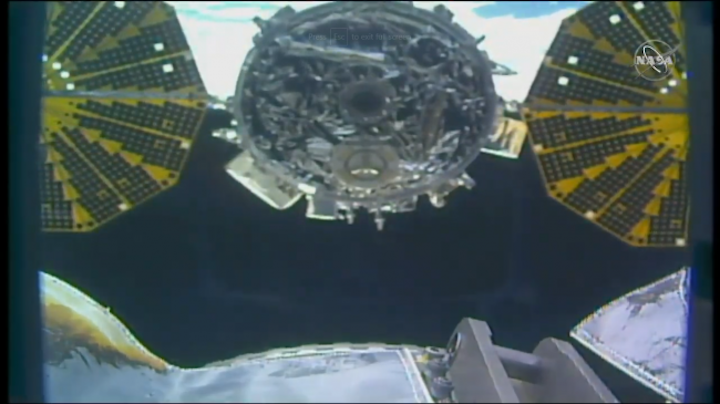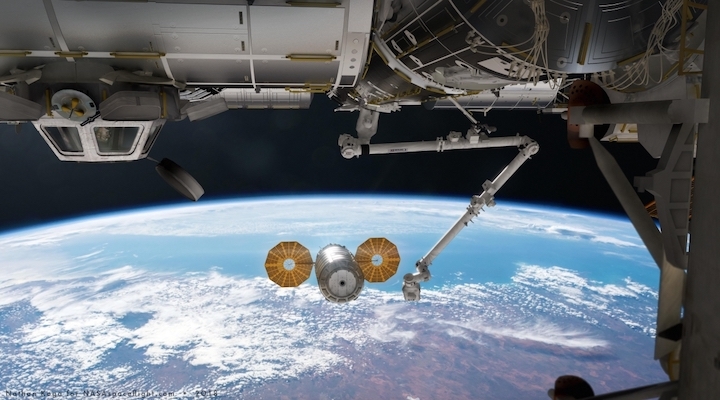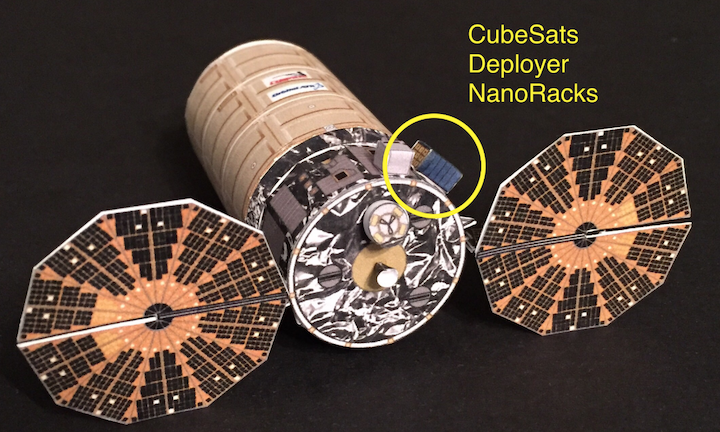7.08.2019
The cargo vessel is taking an extended detour on its way back to Earth.

This afternoon (Aug. 6), over three months after it arrived in orbit, the Northrop Grumman Cygnus cargo spacecraft successfully undocked from the International Space Station and proceeded to drift off into the vacuum of space to begin the second part of its mission.
NASA astronauts Nick Hague and Christina Koch used the space station's Canadarm2 robotic arm to undock the spacecraft and send it on its way. The Cygnus separated from Canadarm2 at 12:15 p.m. EDT (1615 GMT)

An image of the CRS-11 Cygnus undocking from the perspective of Canadarm2.
Launched on April 17, 2019, the Cygnus CRS-11 cargo vessel docked with the space station on April 19. When it arrived, NASA astronaut Anne McClain and Canadian Space Agency astronaut David Saint-Jacques used the Canadarm2 to grapple the craft. The Cygnus, known as the S.S. Roger Chaffee, ferried 7,600 lbs (3,442 kg) of supplies, including science experiments and necessities for the crew, to the station.
Among the science equipment and scientific experiments sent to the station, two Astrobee robots were launched aboard Cygnus (and were joined by a third earlier this summer). Now, one of those little robots has started to fly and begin learning how to assist astronauts on board.
The undocking aired live on NASA TV. Ground controllers remotely unbolted Cygnus from its port on the station and moved it into a release position. Expedition 60 Flight Engineers Christina Koch and Nick Hague then used Canadarm2 to release the craft into space.
Typically Cygnus cargo vessels leave the International Space Station packed with trash, and they burn up in Earth's atmosphere as they fall from space. However, Cygnus will not just burn up this time (or float off into space) — this undocking will be the start of Cygnus's special secondary mission.
After a 3-minute departure burn, Cygnus reached a safe distance away from the space station, it will start deploying small CubeSat satellites using two deployment systems by NanoRacks and SEOPS (Satellite, Extraterrestrial Operations and Procedures).
After about a month of free-flight, NASA’s Seeker Robotic External CubeSat Inspection Vehicle will deploy to move around Cygnus and take high-definition photos, which it will then transmit for storage in its receiver aboard Cygnus.
During this second part of the mission, Cygnus will also demonstrate a Control Moment Gyroscope attitude control system, which rotates the spacecraft and performs operations for the UbiquitiLink payload.
After completing the second part of its mission, Cygnus will burn up in Earth's atmosphere like its predecessors.
Quelle: SC
+++
NG-11 Cygnus departs Station for months of on-orbit free-flight tests

After 110 days at the International Space Station, the Northrop Grumman Innovation Systems (NGIS) NG-11 Cygnus resupply vehicle has departed the orbital outpost.
But in a significant change from previous missions, Cygnus will not perform a destructive re-entry within the next few weeks, instead remaining on orbit until the end of the year to test new systems aboard the craft that will aid NGIS in their ability to offer Cygnus as a free-flying science platform for ISS, non-Space Station, and future NASA needs.
A prolonged mission for NG-11 Cygnus:
After departing the International Space Station, the NG-11 Cygnus will – as is customary – deploy a series of Cubesats from both a forward hatch-mounted deployer and its standard CubeSat deployer mounted on its service module on the rear of the craft.
Speaking directly to NASASpaceflight, Frank DeMauro, Vice President and General Manager of Space Systems Division at Northrop Grumman Innovation Systems, said “We have seven CubeSats total. Four are going to be from the Slingshot system that mounts on the hatch part of Cygnus, and then three will get launched from the NanoRacks CubeSat deployer which is mounted on the outside of the service module.”
But after these releases, the NG-11 Cygnus will enter new territory.
Instead of changing its orbit to maneuver for a destructive deorbit and reentry over the South Pacific, Cygnus will instead begin a multi-month orbital test campaign to validate several new systems that will greatly aid its ability to serve as a free-flying science platform going forward.

These new systems include the first flight of a Control Moment Gyro (CMG) on Cygnus that will enable the craft to maintain its attitude instead of using propellant-driven thrusters.
“The goal of this experiment – and I do want to stress that this is an experiment – is to demonstrate our ability to fly Cygnus with a Control Moment Gyroscope, demonstrate that our avionics and software works well with the CMG, and so we’ll spend a couple of weeks actually doing that particular check out,” related Mr. DeMauro.

